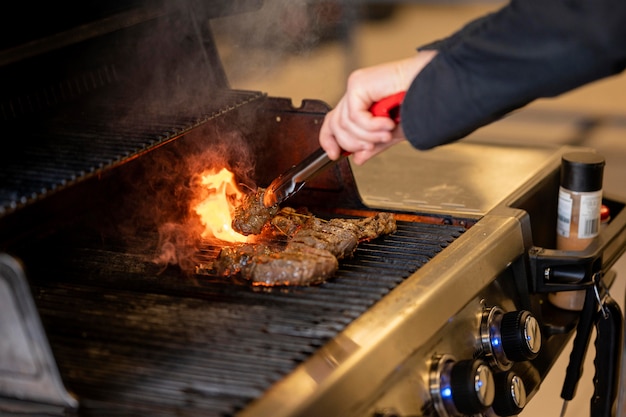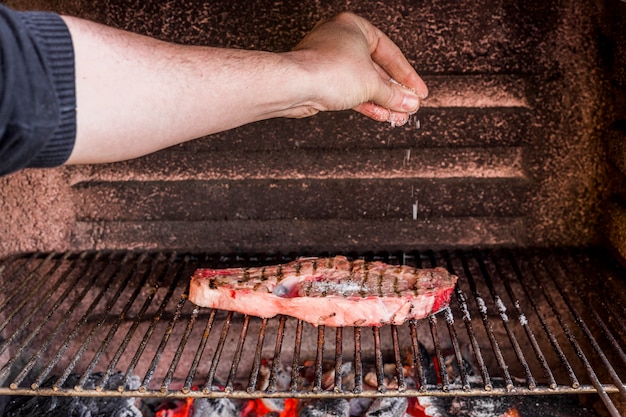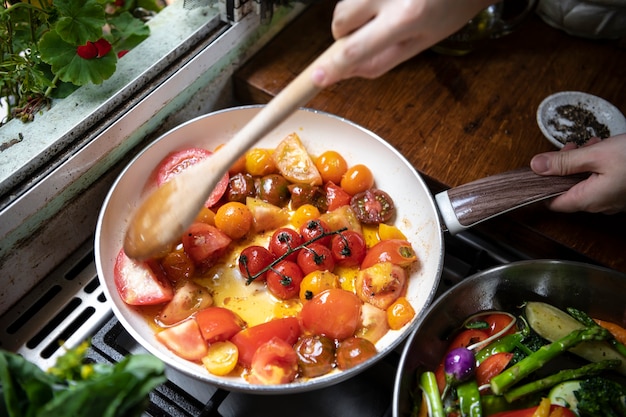There's nothing quite like a perfectly cooked steak – the beautiful sear, the tender texture, the burst of juicy flavour. It's a dish that can elevate any meal, and while it might seem intimidating, it's actually surprisingly achievable. Over the years, I've spent countless hours in the kitchen, perfecting my steak-cooking skills. Now, I'm here to share my secrets, guiding you through the process of creating a steak that's worthy of a Michelin-star restaurant (but without the fancy plating).
(Part 1) choosing the right cut: Your Steak's Foundation

Understanding the Cuts: A Symphony of Flavour
Choosing the right cut of beef is like picking a good bottle of wine – it all depends on what you're looking for. For a tender, intensely flavorful steak, I always recommend a ribeye, new york strip, or filet mignon. These cuts are marbled with fat, making them incredibly juicy and bursting with flavour. But if you're looking for a leaner option, sirloin or flank steak are great choices. Just remember, flank steak is best suited for stir-fries or grilling due to its thinner nature.
The Thickness Factor: The Key to Even Cooking
The thickness of your steak matters, too. Thicker cuts, like a ribeye, are perfect for searing on the stovetop. They hold their heat well, resulting in a beautiful crust and a juicy interior. Thinner cuts, on the other hand, tend to cook faster, so they're better suited for quick searing or stir-fries.
Freshness is King: Choosing Your Beef Wisely
Always, always, always choose fresh, high-quality beef. Look for meat that's a bright red colour, has a good marbling of fat, and smells fresh and pleasant. Avoid any meat that looks discoloured, has an off smell, or feels slimy – this is a sign it's not fresh.
(Part 2) Preparing Your Steak: Setting the Stage for Success

Bringing it to Room Temperature: A Gentle Awakening
Before you even think about touching the stove, bring your steak to room temperature. It's a crucial step in achieving even cooking. Just take it out of the refrigerator 30 minutes to an hour before cooking, allowing it to slowly warm up.
Seasoning Like a Pro: The Art of Simple Flavour
Salt and pepper are the cornerstone of any good steak seasoning, but don't be afraid to get creative. I love to add a pinch of garlic powder, onion powder, and paprika to my steak for an extra layer of depth.
Using a Dry Brine: Enhancing Tenderness and Flavor
For an extra boost of tenderness and flavour, consider dry brining your steak. This involves rubbing your steak generously with salt and leaving it in the refrigerator for a few hours. The salt draws out moisture, then reabsorbs it, creating a more tender and flavorful steak. It's a simple trick that yields amazing results.
Patting it Dry: The Key to a Golden Crust
Once your steak is seasoned, pat it dry with paper towels. This is a vital step that removes excess moisture, allowing for a crispier, more flavorful sear.
(Part 3) Mastering the Stovetop Technique: The Art of Searing

The Power of a Hot Pan: A Vital Element
The stovetop is your canvas, and a heavy-bottomed pan is your brush. Using a cast iron or stainless steel pan is essential for achieving a beautiful sear. Heat your pan over medium-high heat for 5-7 minutes, or until a drop of water sizzles and evaporates instantly. This ensures the pan is hot enough for a perfect sear.
The Art of Searing: A Dance of Heat and Time
Gently place your steak in the hot pan and resist the urge to touch it for 2-3 minutes. This allows the steak to sear properly and develop a beautiful, golden crust on the first side. Once the crust is formed, flip the steak and sear the other side for another 2-3 minutes. This creates an even crust, locking in juices and maximizing flavour.
Using Fat for Flavour: A Luxurious Touch
To add extra flavour and moisture, consider cooking your steak in a tablespoon or two of oil, butter, or even a combination of both. I find a mixture of butter and olive oil creates the best result, but feel free to experiment!
Controlling the Heat: The Final Stage
Once both sides are seared, reduce the heat to medium and continue cooking your steak to your desired level of doneness. Pay attention to the cooking time – remember, thicker cuts require longer cooking than thinner cuts.
(Part 4) Doneness Decoded: Getting it Right Every Time
The Temperature Guide: A Foolproof Method
For those who want precision, a meat thermometer is your best friend. Using a thermometer to gauge the internal temperature is the most accurate way to determine doneness. Here's a guide to the internal temperatures for different levels of doneness:
| Doneness | Internal Temperature (°F) | Internal Temperature (°C) |
|---|---|---|
| Rare | 125-130 | 52-54 |
| Medium Rare | 130-135 | 54-57 |
| Medium | 135-140 | 57-60 |
| Medium Well | 140-145 | 60-63 |
| Well Done | 145 | 63 |
The Touch Test: A More Hands-On Approach
If you don't have a thermometer, don't fret. You can still gauge doneness with the touch test. Gently press the centre of the steak with your finger:
- Rare: Soft and squishy, like a soft marshmallow.
- Medium Rare: Slightly springy, like a bouncy ball.
- Medium: Firm but still slightly springy, like a firmer marshmallow.
- Medium Well: Firm and springy, like a well-cooked marshmallow.
- Well Done: Very firm and hard, like a solid piece of candy.
(Part 5) Resting is Essential: Letting the Steak Relax
Letting the Steak Relax: Releasing the Flavors
Once your steak is cooked to your liking, remove it from the pan and let it rest for 5-10 minutes before slicing. This allows the juices to redistribute throughout the steak, resulting in a more tender and juicy steak. Resist the urge to slice it immediately – patience is key!
Making the Most of Pan Juices: A Delicious Sauce
While the steak is resting, you can make a delicious pan sauce. Simply add a tablespoon or two of butter to the pan, along with any leftover pan juices. Let the butter melt and whisk until it's emulsified with the pan juices. This will create a rich and flavorful sauce that will take your steak to the next level.
(Part 6) Cutting and Serving: The Finishing Touches
Slicing with Precision: Maximizing Tenderness
Cutting your steak against the grain is crucial for achieving a tender, easily chewable steak. This means slicing perpendicular to the muscle fibres. It might seem like a small detail, but it makes a world of difference in the texture of your steak.
The Perfect Plate: A Culinary Masterpiece
Serve your steak with your favourite sides, such as creamy mashed potatoes, roasted vegetables, or a simple green salad. The possibilities are endless! Remember, a good steak deserves a great presentation, so don't be afraid to get creative.
(Part 7) steak sauce Secrets: Elevating the Flavour
Classic Options: A Timeless Symphony of Taste
While a simply seasoned steak can be incredibly satisfying, sometimes a little sauce elevates the flavour to a whole new level. Here are a few classic steak sauce options that complement the richness of the meat beautifully:
- Béarnaise Sauce: A rich and creamy sauce made with egg yolks, butter, and herbs, offering a sophisticated touch to your steak.
- Mushroom Sauce: A rich and earthy sauce made with mushrooms, butter, and wine, perfect for those who love a hearty flavour.
- Peppercorn Sauce: A spicy and flavorful sauce made with cracked peppercorns, butter, and wine, adding a kick to your meal.
Making Your Own: A Personal Touch
You can also make your own steak sauce. It's a great way to customize your meal. Try mixing together:
- Worcestershire sauce
- Soy sauce
- Brown sugar
- Garlic powder
- Onion powder
A Touch of Creativity: Beyond the Classics
Don't be afraid to experiment with different flavours. You can add a touch of sweetness with a glaze made from honey, soy sauce, and garlic. Or for a burst of fresh flavour, try a simple herbed butter with rosemary, thyme, or garlic.
(Part 8) Troubleshooting Common steak mistakes: Avoiding Culinary Disasters
The Overcooked Steak: A Common Mishap
One of the most common steak cooking blunders is overcooking. If you've accidentally overcooked your steak, don't panic! You can try to salvage it by slicing it thin and serving it with a rich sauce to mask the dryness.
The Undercooked Steak: A Safety Concern
On the flip side, an undercooked steak can be a safety hazard. If you're concerned about your steak being undercooked, cook it a little longer. Remember, it's better to be safe than sorry.
The Tough Steak: A Texture Issue
If your steak turns out tough, it's likely due to the cut of meat or the cooking method. Choose a more tender cut of beef and make sure to cook it over medium heat.
The Burnt Steak: A Case of Overzealousness
Sometimes, we get carried away and end up with a burnt steak. If this happens, just trim off the burnt parts and try to salvage the rest.
(Part 9) Beyond the Basics: Elevating Your Steak Game
Adding a Touch of Smoke: A Smoky Delight
For an extra layer of flavour, consider adding a touch of smoke. You can do this by using a smoker, a grill, or even a smoking gun. The smoky flavour complements the rich taste of steak beautifully.
Glazing for Extra Shine: A Touch of Glamour
Just before serving, brush your cooked steak with a mixture of honey, soy sauce, and garlic. This creates a delicious glaze that adds a beautiful shine and a hint of sweetness.
Herbed Butter: A Luxurious Indulgence
A simple herbed butter can elevate your steak to new heights. Mix chopped herbs like rosemary, thyme, or garlic with softened butter and spoon it over your cooked steak. It's a simple yet elegant touch that adds a burst of flavour.
FAQs
Q: What's the best pan for cooking steak?
A: A heavy-bottomed pan, like cast iron or stainless steel, is ideal for searing steak. These pans retain heat well and help create a beautiful crust.
Q: How do I know if my steak is done?
A: The most accurate way to determine doneness is to use a meat thermometer. You can also use the touch test, but it's not as reliable.
Q: What's the best way to rest a steak?
A: After cooking, let your steak rest for 5-10 minutes before slicing. This allows the juices to redistribute throughout the steak, resulting in a more tender and juicy steak.
Q: What are some good sides for steak?
A: Some classic steak sides include mashed potatoes, roasted vegetables, asparagus, and green salad. But feel free to get creative with your sides – the possibilities are endless!
Q: What are some tips for preventing a tough steak?
A: Choose a tender cut of beef, cook over medium heat, and don't overcook the steak. These simple tips will ensure a tender and delicious steak every time.
With a little practice and a good dose of confidence, you can create the perfect stovetop steak that will impress your guests and satisfy your cravings. Now go forth, embrace the art of steak cooking, and enjoy the fruits of your culinary labour!
Everyone is watching

Corn on the Cob: The Ultimate Guide to Perfectly Cooked Ears
Healthy MealsAh, corn on the cob. Just the name evokes images of sunny days, barbecues, and that sweet, juicy flavour that ...

Perfect Pork Roast Oven Cooking Time: A Guide to Delicious Results
Healthy MealsThere's something truly satisfying about a perfectly roasted pork. The aroma alone is enough to make your mout...

Ham Cooking Time: How Long to Bake, Smoke, or Boil a Delicious Ham
Healthy MealsAh, ham. It's a classic, isn't it? A real crowd-pleaser, especially around holidays. And when done right, it'...

Scallops: The Ultimate Guide to Perfect Cooking
Healthy MealsAh, scallops. Those delicate, sweet, and utterly delicious morsels of the sea. They hold a special place in my...

Spaghetti Squash: The Ultimate Guide to Cooking and Serving
Healthy MealsRemember that time you saw spaghetti squash at the supermarket, looking all bumpy and strange, and thought, "W...
